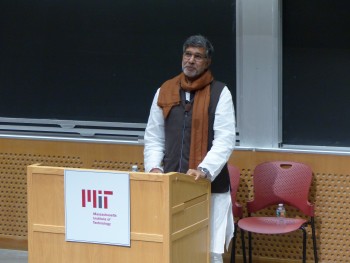by Connie E
Kailash Satyarthi was the joint 2014 Nobel Peace Prize laureate with Malala Yousafzai. A group of us were lucky enough to meet him at MIT on October 17. To me, Nobel Prize winners have always seemed to have a “halo” over their head that makes them somehow distant and unapproachable. However, Kailash is truly a man of compassion – he spoke about his humanitarian work with enthusiasm as well as humility. If there was one take-away from the event, I’d say it was his belief that we need collective actions with a sense of urgency in order to solve the issue of child slavery, a crime against humanity.
To put the issue into perspective, there are currently 215 million children employed as child laborers worldwide, out of which 115 million are working in hazardous occupations. The condition is worse in developing countries in Asia and Latin America. Although we all have products from Nike, Adidas and Apple, many of us are not familiar with the behind-the-scene situations of millions of child labors in developing countries. Mr. Satyarthi has been the architect of the single largest civil society network for the most exploited children, the Global March Against Child Labour, whose mobilization of unions, civil society and most importantly, children, led to the adoption of ILO Convention 182 on the worst forms of child labour in 1999. He was awarded the Nobel Peace Prize for his “struggle against the suppression of children and young people and for the right of all children to education.”
 During the talk, Mr. Satyarthi recalled the story of a girl that’d just been rescued — due to years of imprisonment in the factory, she hadn’t even known that bananas needed to be peeled. Since those children were totally unable to survive independently upon rescue, it was reassuring to hear that the Satyarthi Foundation also provides support like trauma counseling, transit rehabilitation centers, and ensures post-treatment care by helping with access to compensation and relevant government schemes. These efforts ensure that children are protected and are not vulnerable to being re-trafficked. During the talk, Mr. Satyarthi also recounted his experiences being in some very dangerous environments in order to save children’s lives – having guns pointed at his head or being injured was not that unusual in his early years. But according to him, this difficult work had to be done and he needed to be at the frontline.
During the talk, Mr. Satyarthi recalled the story of a girl that’d just been rescued — due to years of imprisonment in the factory, she hadn’t even known that bananas needed to be peeled. Since those children were totally unable to survive independently upon rescue, it was reassuring to hear that the Satyarthi Foundation also provides support like trauma counseling, transit rehabilitation centers, and ensures post-treatment care by helping with access to compensation and relevant government schemes. These efforts ensure that children are protected and are not vulnerable to being re-trafficked. During the talk, Mr. Satyarthi also recounted his experiences being in some very dangerous environments in order to save children’s lives – having guns pointed at his head or being injured was not that unusual in his early years. But according to him, this difficult work had to be done and he needed to be at the frontline.
A highlight of the event was when a 9-year-old boy asked Mr. Satyarthi what he could do to help those children in India. Touched and impressed by this boy’s courage, Mr. Satyarthi invited him onstage and told him that there were lots of things children can do to help – examples include asking their parents to refuse to buy products produced from factories that employ child labors, spreading the awareness of the issue among their friends, and writing to their Senator/Congressman about the seriousness of this issue.
What can be done to tackle the root cause of this problem? If child traffickers are not properly dealt with by the government, Mr. Satyarthi’s work is going to be a no-end game. A joint effort from the government, NGOs, and international organizations such as UNICEF and the World Bank is needed in order to eliminate, rather than alleviate the problem of child trafficking. Meanwhile, consumers also need to be more aware of how the products they’re buying are produced. Businesses also carry the role of upholding their ethical standards by resisting child labor from third world countries.
I couldn’t think of a more appropriate word than inspiring to describe this talk. And my initial assumption that Nobel Prize winners are intimidating and unapproachable was wrong – see, Kailash even took a selfie with us.


